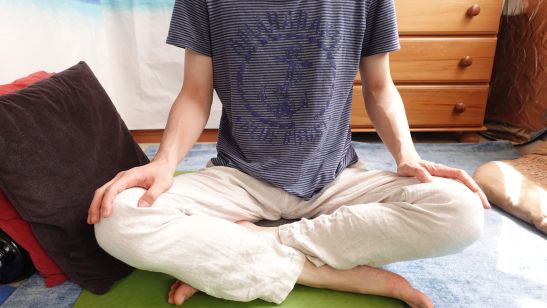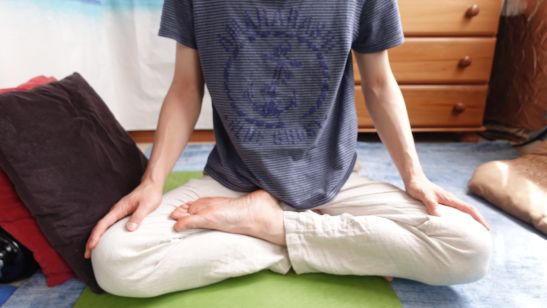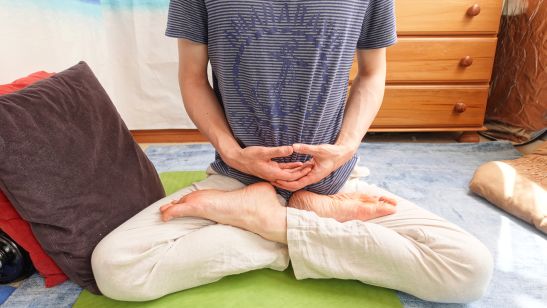Meditation Sitting Posture
"How to deal with the pains in meditation?"
Introduction
Defining Meditation Sitting Posture
Meditation is one of the most useful practices that you will ever pick up in life.
Through the practice, you will be able to gain insight into yourself and discover the solutions to all your problems. Meditation will help you to illuminate the source of all your darkness and confusion.
However, this inward journey can be difficult because of the pains and discomfort one can experience in the practice. When one experiences unpleasantness in the practice, self-doubts can arise. One can even begin to question whether their techniques, their inner experiences, their sitting postures, and so forth are been done correctly. Discomfort and Self-doubt can lead to demotivation, which can lead to the abandonment of this wonderful practice.
In this article, we will explore painful sensations experienced in meditation and the posture aspect of the practice so that one can stop dwelling in the unnecessary confusions, which will help one to go deeper into their inward journey.
Meditation Sitting Posture In Depth
What is the correct sitting posture?
To know the answer to this question, one needs to know the purpose of meditation. Because if one does not know the point of meditation, how would one know about the point of posture?
So, let us explore the purpose of meditation.
The Purpose Of Meditation
It was discovered that if one lives looking outwards, one will slowly come to know the world outside, and likewise, if one were to live looking inwards, one will be able to know the world inside —The World Of The Self, of one's existence. This simple truth was discovered by those who wished to seek for answers to their existence.
But how to close one’s eyes and observe the world within for a long time without falling asleep? How to distinguish between observing the inner world and imagining what it is?
In order to develop Self-Knowing, one must be able to remain awake and focused whilst observing the Inner-World. So, the upright sitting posture was adopted. In the beginning, people meditated on the ground, some meditated sitting inside, some outside, some on chairs. Very few people meditated whilst lying down because one can end up losing focus and falling asleep.
However, different sitting postures / preferences arose from different regions, religions and groups. With time as the practice of meditation spread, people began using meditation for different purposes, i.e. to practise magic, qikong, energy manipulation, channeling, praying, and so forth. And as the purpose became many, so too did different meditation postures emerge.
But for the purpose of Self-Knowing, Self-Transformation, Self-Realization, and Enlightenment, one can just adopt a sitting posture that suits them. So, at the end of the day, whether one sits on a chair or on the ground, or to use a cushion or not, it is simply a matter of personal choice because the key is to just get into a position where the mind can be constantly alert and awake for one to carefully observe the inner world without falling asleep.
If standing is your cup of tea, then go for it. But how difficult it is to stand closed eyes for long periods of time without losing one's balance? How tiring it is to stand than to sit? So, that is why you don’t see many standing meditation postures. You can actually just imagine and try all the meditation postures you can think of yourself. And what you will find that the best meditation postures from trial and error would usually come down to the following few meditation postures:
There is a cross-legged position that most people know. We all had to sit like this in school when there were no seats.

Then there is the Burmese position that is quite similar to the cross-legged position. I tend to meditate in this position because it’s more comfortable as there’s less stress on the knee and ankle against ankle. However, one may need to do some yoga or flexibility exercises to open up their joints to get into the Burmese position if they are inflexible. I usually use around 2-3 cushions in the Burmese position.

This is the half-lotus position that I usually do if I want to experience more pain in meditation. Experiencing pain in meditation is a great way to develop even greater Stillness. See Catalyst - Pain.

There is also the full-lotus position that I would really avoid unless you are naturally born flexible to get into such a position or you’ve practised yoga for many years to become that flexible. Otherwise, sitting for long periods in the lotus position when your body is not ready can really stress your joints.

Whatever meditation posture you choose to be in, maintaining the straightness of your back, relaxing the shoulders, keeping your posture still as you meditate, doing these things will help you to go deeper into your meditation.
Having explored some of the meditation postures, let us explore the pains experienced in the practice of meditation to see what they really mean.
Path Of Creator
Meditation Sitting Posture In Relation To The Path Of Creator
Let me share with you what I have discovered after meditating for long periods of time. I have been meditating for more than 10 years. And during this time, I have gone to more than 6 Vipassana sessions which is a 10-day meditation retreat where you had to meditate 10 hours every day.
These 10 day Vipassana sessions made me realize that a lot of pain that we experience in life are really in the mind. Because usually on the first few days, I would experience so much pain on my legs as if they were about to come apart. But as the day progresses, the pain would become less and less as I meditated more. Usually, one would think that if sitting on the ground is the cause of the pain, wouldn’t sitting on the ground more and more cause more pain?
But through the meditation experience, I discovered that there are actually two types of pains. One is the physical pain and the other is the mental pain. Usually, it’s the latter that will make one give up their meditation practice.
Realize that the more Still your mind is, the less you will be reacting to the pains you are experiencing. So, if you can learn to simply observe the pain as is, there will be not much mental pain but simply the physical pain, which really when you observe with a still mind is not that painful at all. From experience, if you can meditate with a Still Mind, you will react less to the physical pain to the point where tensions will slowly cease to be produced on the body, and with time, all the pain that you experience on the body will seemingly disappear like magic. But this state of Stillness of the mind takes a lot to reach if there are still unresolved issues deep in the mind. However, it can be forcefully reached through meditating for a very long time.
Unstillness of the Mind will always make pain more painful.
It’s kinda like this. If your parents say something stupid when your mind is Still, you will probably not feel so much pain because you can just observe the stupidity as it is. However, if you’ve had a bad night sleep and wake up with a mind less capable of Stillness, any slight pain that comes into your daily experience will cause much more mental pain.
Some possible causes to your pains in meditation
So, if you are experiencing more pains than normal in your meditation practices, the causes can be many.
For example,
1. When you meditate with a stimulated mind. Perhaps you’ve been doing a lot of thinking or imagining in the last few hours or days. Because of your unstill mind, you can end up subconsciously reacting to the pains that are arising in your meditation experience.
2. Perhaps you are going through some suffering experiences in your life. Maybe there’s a problem that is nagging you in your life. Maybe you are worried about something. Maybe someone has hurt your feelings. So, your sufferings can cause Unstillness of the mind, which will lead to greater pain in meditation sessions.
3. Perhaps you are tired, which will cause you to have less energy to be Still in your meditation practice. Perhaps your body is stressed out by what you’ve been eating. As a result, your body can end up redirecting all its energy to healing itself with little left for you to use to develop greater Stillness.
Let us explore the solutions.
1. Just meditate and try to observe the experience as is. You can do this by simply observing the breath. The more you try to simply observe the experience rather than judging it, the more your mind will be Still. And in turn, this will allow the deeper wandering thoughts to surface. So, it will seem to get slightly chaotic in the beginning, but the more you choose to simply observe, the mind will slowly unwind itself until all the wandering thoughts are released.
2. Just meditate and try to observe the experience as is. Discovering and experiencing inner pains is the only way to release them and also to know the source naturally. Initially, you may only think that you are observing some sort of physical pain and discomfort through meditation, but with time, as you try to simply observe the experience as it is, you will slowly realize the mental and emotional pains behind your uncomfortable experiences. So, pains can be used as a gateway to even greater self-knowing!
3. Just meditate and try to observe the experience as is! This will help your body to slowly recover. The less you engage in thinking and reacting, the more the body will naturally heal from all the stress you’ve given it. Try to eat healthier can also help you with your sittings.
So, as you can see, the solution to all the pains that you are experiencing is to simply just observe the experience as it is, aiming for Stillness of the mind.
In short, if you are experiencing self-doubt, just realize that as long as you are meditating whilst sitting upright, you are meditating correctly. Pains is just a part of the process of Self-Knowing and Self-Transformation because through experiencing pain, you will come gain greater insight into yourself.
A tip to develop even greater Stillness of the mind is to just try to keep your posture absolutely still. This will help the mind to be more focused in the practice.
If you wish to use meditation to transform the mind, realize that pain is actually a powerful catalyst that you can use for self-transformation. So, ideally, you want to bring out and accept as much pain in your meditation practice. This catalyst can be too difficult to handle for most, but the reason why I say this is to suggest to you the potential of pain to be used as a great catalyst for Self-Transformation. Because the more you can experience, discover and face pains in your meditation practices, the more opportunities there will be for Self-Transformation. So, if you meditate with a mindset to avoid pains, you may have a somewhat pleasant experience but unfortunately not much Self-Knowing or Self-Transformation.
Know and Transform The Self!
Reading articles helps with understanding, but to transform the mind, one realizes the truth from experience.
For such an enlightening journey, the Self-Transformation Course has everything you will ever need!


